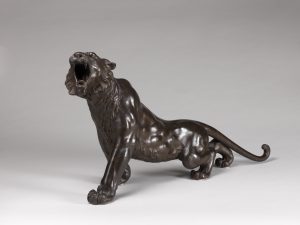Collecting around the same time as the Reids, Jane Hill Told’59 and William H. Told, Jr. formed most of their collection in a way similar to the Reids: most of the objects from their collection were purchased from galleries and at Asian Art fairs in the United States. Some other objects were given by friends or acquired during travel, which illustrates a more personal and spontaneous approach to collecting Asian art. For example, this tiger was documented as a gift from a friend before 1996 when it was gifted to the museum in 2016. While it is understood that the exact dates of previous transactions and the origin of the objects might not be well documented on gifting occasions, this Okimono tiger presents certain difficulties for further investigation of its provenance. Therefore, it is important to return to the object itself for the answer.
Okimono, 置物, is a Japanese term for decorative objects. Typically found in a tokonoma, alcove in the reception room of the house, okimono is usually a small decorative sculpture depicting animals, mystical beast, deities, humans, fruits, plants, and sometimes even a scene from a story made from a wide range of materials from ivory to cast iron. Traditionally a Japanese art form, okimono was widely made to export to the west during the 20th century. As the Smith’s okimono tiger was made during the same period, it is highly possible that it was created to meet western expectations of Asian art and purchased as a souvenir. The marks on the belly of the tiger, Atsuyoshi 厚義 and Maruki shachū seisaku まるき社中製作 help us identify the marker as Atsuyoshi and further confirm the object as a piece of export art produced by the Maruki company.
